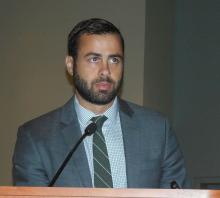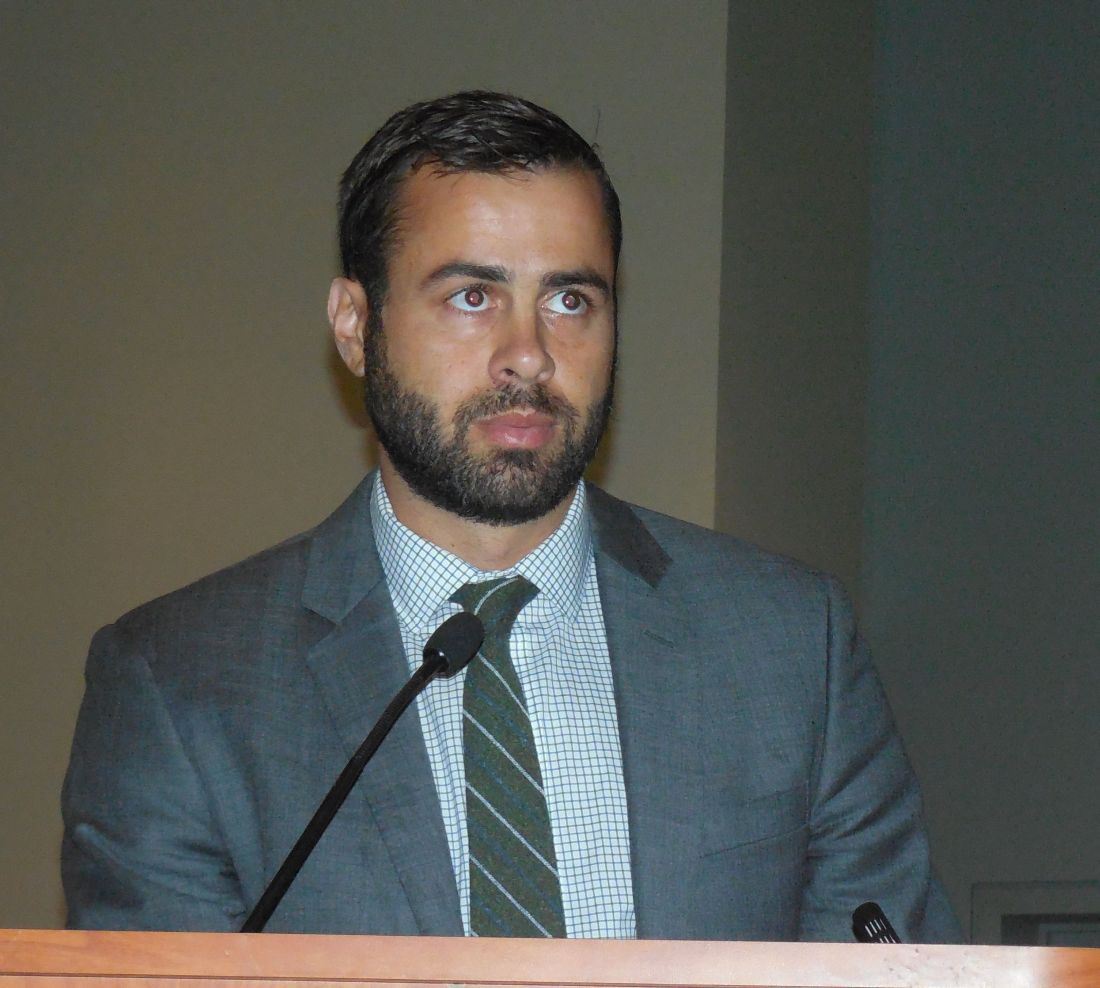User login
WASHINGTON – , a finding with potentially important implications for prognosis and management.
Systematic assessment of 349 American patients diagnosed with sarcoidosis – 264 whites and 85 blacks – showed that black patients had nearly double the prevalence of advanced, end-stage, Scadding stage IV fibrosis in their lungs, with a 19% rate among whites and a 34% rate among blacks, confirming that blacks generally have worse sarcoidosis, Andy Levy, MD, said at an international conference of the American Thoracic Society.
Honeycomb scar is associated with more restrictive disease, characterized by reduced total lung capacity and reduced diffusing capacity of the lungs for carbon monoxide, features seen in these black stage IV patients, said Dr. Levy, a pulmonologist at National Jewish Health in Denver. Bronchovascular distortion, the more common scar pattern seen in the white patients, results in more obstructive symptoms, such as a reduced ratio of forced expiratory volume in 1 second divided by forced vital capacity, which Dr. Levy reported as a characteristic of the white GRADS patients.
Even though the pulmonary fibrosis was end-stage in all the black and white stage IV patients examined, “where the scar occurs may depend on genetics or environment, and may affect how the disease manifests. We don’t fully know what it means yet,” Dr. Levy said in an interview. “There is this difference in the sarcoidosis of some black patients compared with white patients that needs further investigation to figure out why the scar is different.”
The different distribution of lung fibrosis in blacks and whites “could have huge implications for prognosis and management,” said Laura Koth, MD, a pulmonologist and professor at the University of California, San Francisco, and lead investigator for the study reported by Dr. Levy.
The GRADS data collection also showed that a significantly higher percentage of black patients had most recently received prednisone treatment for their sarcoidosis, 45% compared with 29% in whites, Dr. Levy reported. Ideally most sarcoidosis patients would be on a steroid-sparing regimen, such as methotrexate. The excess prednisone treatment the black patients received confirmed prior reports of treatment disparities by race among American sarcoidosis patients, he said.
GRADS includes patients enrolled at seven U.S. research centers. The study’s primary goal is to try to identify “genomic signatures” that link with the clinical phenotypes identified through spirometry, bronchoscopy, CT scans, and physical examinations, Dr. Koth explained. The investigators plan to enroll more patients into the program to validate the findings, she said. “This is an early stage, but we have seen some signals we want to follow-up.”
GRADS is funded by the National Heart, Lung, and Blood Institute. Dr. Levy and Dr. Koth had no relevant financial disclosures.
mzoler@frontlinemedcom.com
On Twitter @mitchelzoler
WASHINGTON – , a finding with potentially important implications for prognosis and management.
Systematic assessment of 349 American patients diagnosed with sarcoidosis – 264 whites and 85 blacks – showed that black patients had nearly double the prevalence of advanced, end-stage, Scadding stage IV fibrosis in their lungs, with a 19% rate among whites and a 34% rate among blacks, confirming that blacks generally have worse sarcoidosis, Andy Levy, MD, said at an international conference of the American Thoracic Society.
Honeycomb scar is associated with more restrictive disease, characterized by reduced total lung capacity and reduced diffusing capacity of the lungs for carbon monoxide, features seen in these black stage IV patients, said Dr. Levy, a pulmonologist at National Jewish Health in Denver. Bronchovascular distortion, the more common scar pattern seen in the white patients, results in more obstructive symptoms, such as a reduced ratio of forced expiratory volume in 1 second divided by forced vital capacity, which Dr. Levy reported as a characteristic of the white GRADS patients.
Even though the pulmonary fibrosis was end-stage in all the black and white stage IV patients examined, “where the scar occurs may depend on genetics or environment, and may affect how the disease manifests. We don’t fully know what it means yet,” Dr. Levy said in an interview. “There is this difference in the sarcoidosis of some black patients compared with white patients that needs further investigation to figure out why the scar is different.”
The different distribution of lung fibrosis in blacks and whites “could have huge implications for prognosis and management,” said Laura Koth, MD, a pulmonologist and professor at the University of California, San Francisco, and lead investigator for the study reported by Dr. Levy.
The GRADS data collection also showed that a significantly higher percentage of black patients had most recently received prednisone treatment for their sarcoidosis, 45% compared with 29% in whites, Dr. Levy reported. Ideally most sarcoidosis patients would be on a steroid-sparing regimen, such as methotrexate. The excess prednisone treatment the black patients received confirmed prior reports of treatment disparities by race among American sarcoidosis patients, he said.
GRADS includes patients enrolled at seven U.S. research centers. The study’s primary goal is to try to identify “genomic signatures” that link with the clinical phenotypes identified through spirometry, bronchoscopy, CT scans, and physical examinations, Dr. Koth explained. The investigators plan to enroll more patients into the program to validate the findings, she said. “This is an early stage, but we have seen some signals we want to follow-up.”
GRADS is funded by the National Heart, Lung, and Blood Institute. Dr. Levy and Dr. Koth had no relevant financial disclosures.
mzoler@frontlinemedcom.com
On Twitter @mitchelzoler
WASHINGTON – , a finding with potentially important implications for prognosis and management.
Systematic assessment of 349 American patients diagnosed with sarcoidosis – 264 whites and 85 blacks – showed that black patients had nearly double the prevalence of advanced, end-stage, Scadding stage IV fibrosis in their lungs, with a 19% rate among whites and a 34% rate among blacks, confirming that blacks generally have worse sarcoidosis, Andy Levy, MD, said at an international conference of the American Thoracic Society.
Honeycomb scar is associated with more restrictive disease, characterized by reduced total lung capacity and reduced diffusing capacity of the lungs for carbon monoxide, features seen in these black stage IV patients, said Dr. Levy, a pulmonologist at National Jewish Health in Denver. Bronchovascular distortion, the more common scar pattern seen in the white patients, results in more obstructive symptoms, such as a reduced ratio of forced expiratory volume in 1 second divided by forced vital capacity, which Dr. Levy reported as a characteristic of the white GRADS patients.
Even though the pulmonary fibrosis was end-stage in all the black and white stage IV patients examined, “where the scar occurs may depend on genetics or environment, and may affect how the disease manifests. We don’t fully know what it means yet,” Dr. Levy said in an interview. “There is this difference in the sarcoidosis of some black patients compared with white patients that needs further investigation to figure out why the scar is different.”
The different distribution of lung fibrosis in blacks and whites “could have huge implications for prognosis and management,” said Laura Koth, MD, a pulmonologist and professor at the University of California, San Francisco, and lead investigator for the study reported by Dr. Levy.
The GRADS data collection also showed that a significantly higher percentage of black patients had most recently received prednisone treatment for their sarcoidosis, 45% compared with 29% in whites, Dr. Levy reported. Ideally most sarcoidosis patients would be on a steroid-sparing regimen, such as methotrexate. The excess prednisone treatment the black patients received confirmed prior reports of treatment disparities by race among American sarcoidosis patients, he said.
GRADS includes patients enrolled at seven U.S. research centers. The study’s primary goal is to try to identify “genomic signatures” that link with the clinical phenotypes identified through spirometry, bronchoscopy, CT scans, and physical examinations, Dr. Koth explained. The investigators plan to enroll more patients into the program to validate the findings, she said. “This is an early stage, but we have seen some signals we want to follow-up.”
GRADS is funded by the National Heart, Lung, and Blood Institute. Dr. Levy and Dr. Koth had no relevant financial disclosures.
mzoler@frontlinemedcom.com
On Twitter @mitchelzoler
AT ATS 2017
Key clinical point: A restrictive, “honeycomb” fibrotic scar was more common in black patients with stage IV sarcoidosis than in white stage IV patients, who more often had obstructive bronchovascular distortion.
Major finding: Honeycomb lung fibrosis occurred in 19% of black sarcoidosis patients and in 4% of white sarcoidosis patients.
Data source: GRADS, which enrolled 349 sarcoidosis patients at seven U.S. centers.
Disclosures: GRADS is funded by the National Heart, Lung, and Blood Institute. Dr. Levy and Dr. Koth had no relevant financial disclosures.

